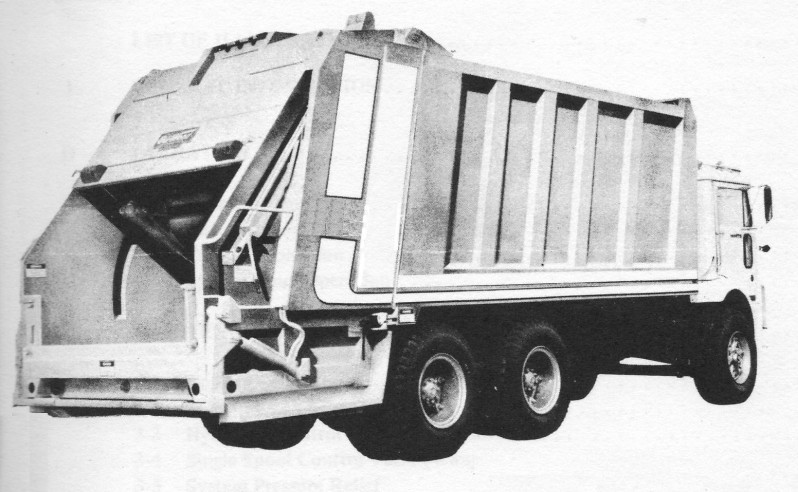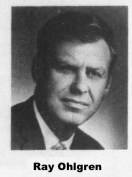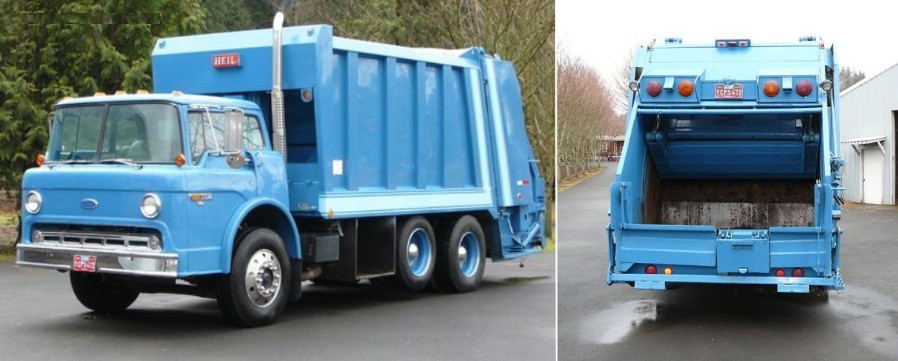 
Chapter 22
The End of Gar Wood

With the Gar Wood product line completely overhauled, the end of the decade could have been a time for the company to grow and increase its market share. Most of the other unprofitable divisions had been sold, allowing concentration of engineering and development on refuse bodies. And the engineering effort had been fruitful: the troublesome T-series and LP-800 were long gone, replaced by the rugged and popular LP-900. The FL-3000 had finally given them at least a toehold in the front loader field, and the all-new (if un-orthodox) Ten Hundred was a bold and forward-looking design.
Despite the improved outlook, the decision was taken to permanently shut down Gar Wood manufacturing operations in the United States. The refuse bodies created by Fred Smith were well designed and securely patented by Sargent Industries, and the portfolio would be licensed around the world to the highest bidders. Gar Wood employees and distributors were notified on October 27, 1978 that production would cease early the next year. In February, 1979, a deal was reached with Clement Industries of Minden, Louisiana, whereby Clement purchased the rights to what was the old St. Paul Hydraulic Hoist division, which produced Gar Wood dump truck bodies.
 General Manager Ray Ohlgren, who joined the company a few months earlier, seemed surprised, telling Solid Wastes Management Magazine that Gar Wood was then experiencing their biggest ever backlog of orders. The fact the Ohlgren had formerly worked for The Heil Company may have played a role in the fate of Gar Wood.
On April 6, 1979, a licensing agreement was reached with Heil, granting them exclusive rights to manufacture and sell most of the former Gar Wood refuse body product line in North America, including the LP700, LP900 and LP10 00 rear loaders, with Heil agreeing to honor warranty and service on most existing Gar Wood packers. This agreement was not a "buyout" of Gar Wood Division as is often erroneously reported. Heil did not purchase the Enterprise factory in the deal, which was closed down permanently. The Gar Wood tooling was advertised for sale in June of that same year. It was shipped to Germany, where it was used to build licensed models for the European market. General Manager Ray Ohlgren, who joined the company a few months earlier, seemed surprised, telling Solid Wastes Management Magazine that Gar Wood was then experiencing their biggest ever backlog of orders. The fact the Ohlgren had formerly worked for The Heil Company may have played a role in the fate of Gar Wood.
On April 6, 1979, a licensing agreement was reached with Heil, granting them exclusive rights to manufacture and sell most of the former Gar Wood refuse body product line in North America, including the LP700, LP900 and LP10 00 rear loaders, with Heil agreeing to honor warranty and service on most existing Gar Wood packers. This agreement was not a "buyout" of Gar Wood Division as is often erroneously reported. Heil did not purchase the Enterprise factory in the deal, which was closed down permanently. The Gar Wood tooling was advertised for sale in June of that same year. It was shipped to Germany, where it was used to build licensed models for the European market.
The end came after 40 years of building compaction refuse trucks, and for most of those years Gar Wood was the industry leader in sales. The company had achieved many important engineering 'firsts' in refuse body history. Founder Garfield Wood had invented the hydraulic hoist in 1911, which led to improved dump-type refuse trucks. The 1937 Load-Packer broke open the American market for compaction refuse trucks, and dominated the industry for many years afterward. They built the first rotary-sweep refuse packer in 1957 (LP-500), and the first unitized refuse truck in America (T-100), the latter model also pioneered the use of the swing-link packer system in rear loaders. An unprecedented engineering program during the Sargent years made Gar Wood the most innovative company in their field. Their very last model, the ill-fated Ten Hundred, was at least a decade ahead of its time with its curved-shell body. For generations of operators, Gar Wood was the first name in refuse bodies. Although the company is now a distant memory, it is fitting that its legacy lives on under various brand names around the world to this day.
Although the Gar Wood name had vanished forever in America, the legacy lived on as licensed production continued worldwide under numerous other manufacturers. The following describes some of the more notable examples built from 1978 to the present.

The Heil Formula 5000 is easily identified by vertical body bracing, compared to slanted pillars of the LP-900
Despite controlling the Gar Wood patent rights for North America since 1979, The Heil Company has built only the LP-900 rear loader, renamed the Heil Formula 5000. The vertical body pillars easily differentiate the Formula 5000 from all other versions of this design, which use forward-slanted posts. It replaced the high-compaction Colectomatic Mark V, which had been embroiled in a lawsuit filed by the Leach Company of Oshkosh, Wisconsin. Heil purchased the rights to two other Gar Wood rear loaders, the LP700 and LP1000. Feasibility studies were made on the Ten Hundred, but ultimately neither model was ever built by Heil. Similarly, the management at Heil passed on buying the Gar Wood FL-3000 front loader, and that design would never see production again in the USA.
If Heil had not been in the market for a high-compaction rear loader to replace the Mark V, the future of the LP-900 design may have been quite different. Sargent may have sold the rights to any number of established American manufacturers, or even to an upstart company. Ultimately, the outcome was good for both Sargent and Heil, and cemented Fred Smith's LP-900 as one of the greatest rear loader designs of all time. In regular USA production from 1972 to the present, it recently reached another milestone of some renown: counting the LP-900 and Formula 5000 as a single body design, it has now been manufactured longer than all previous Gar Wood models combined, from the first Load-Packer to the Ten Hundred.
REFERENCES
Solid Wastes Management/Refuse Removal Journal, November 1978, page 4
Editorial-Gar Wood: A Sense of Loss
Solid Wastes Management/Refuse Removal Journal, February 1979, page 8
Gar Wood Hoist, Body Lines sold to Louisiana Company
Solid Wastes Management/Refuse Removal Journal, April 1979, page 10
Heil Gets License to Make Gar Wood Rear Loader Bodies
Solid Wastes Management/Refuse Removal Journal, December 1979, page 48
Heil Introduces its Newly Adapted Rear Loader Packer to the Industry
A Formula For Success:
A History of The Heil Company 1961 To The Present
Chapter 19 Heil LP-900, The Demise of the Mark V
Eric Voytko, May 29, 2017 (Classic Refuse Trucks)
Vintage Gar Wood Literature in PDF at the Classic Refuse Trucks Library
Vintage Gar Wood Advertisements at the Classic Refuse Trucks Library
Known peserved Gar Wood bodies
|


7/30/14 (revised 2/15/21)
© 2014 Eric Voytko
All rights reserved
Photos from factory brochures/advertisements except as noted
Logos shown are the trademarks of respective manufacturers
|
| |